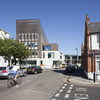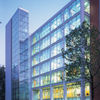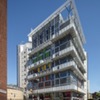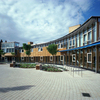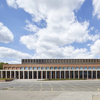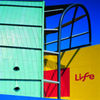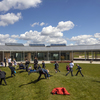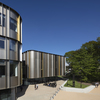Francis Crick Institute
Subscribe now to instantly view this image
Subscribe to the Architects’ Journal (AJ) for instant access to the AJ Buildings Library, an online database of nearly 2,000 exemplar buildings in photographs, plans, elevations and details.
Already a subscriber? Sign in
The curved roof
Anthony Coleman Download Original
A 91,000m² biomedical research laboratory in London that researches diseases such as cancer, heart conditions and neurodegenerative diseases.
The institute is organised into quadrants of labs united by full-length and full-width atriums – nave and transepts – with a crossing, at which point its main staircase rises. At their most expansive these atriums are 24m and 50m high. The building has six floors above ground, topped by a triple-height curved roof of aluminium slats, which hide the substantial plant needed – more than a third of the building is devoted to plant and services. The ground floor is reached by a dual-level main entrance on the building’s east side.
The design intent was to develop an overall architectural concept that promotes interdisciplinary work and encourages collaboration between scientists and researchers, while creating a brand new civic landmark of notable architectural expression in King’s Cross. The use of BIM was imperative to ensure the speed and accuracy of the interdisciplinary coordination necessary to achieve early release of structural packages. BIM was also important for automating design iterations, which inevitably had to be tested on a project of this scale and complexity, ensuring optimisation of end product.
Excavation and construction of one of London’s largest basements on a site constrained on all four sides by buried obstructions – including the Thameslink station box and two 120-year-old cast-iron gas mains serving Camden Town – called for a completely bespoke strategy. The result was a delicate balance between structural efficiency, cost, programme and site logistics, relying on complex 3D ground modelling and live on-site movement monitoring to ensure the ongoing integrity of all surrounding third-party assets.
Data
- Completed: 2016
- Floor area: 91,000m2
- Sectors: Healthcare, Education
- Total cost: £460M
- Procurement: Two stage Design and Build
- Address: 1 Midland Rd, London, NW1 1AT, United Kingdom
Professional Team 
- Architect: HOK with PLP
- Project architect: David King
- Client: Francis Crick Institute
- Structural engineer: AKT II
- MEP consultant: Arup
- Quantity surveyor: T&T
- Biological research facility consultant: BMJ
- Acoustic consultant: Cole Jarman
- Shielding consultant: VitaTech
- Cladding consultant: EPPAG
- Specialist lighting consultant: Porkorny Lichtarchitektur
- Catering consultant: Foodesco
- Access consultant: Reef
- IT Consultant: Cordless
- Security consultant: Horus
- Fire consultant: Exova Warrington Fire
- Planning consultant : CBRE
- Environmental consultant: URS
- Project manager: Arup
- CDM Co-ordinator: Rider Levett Bucknell
- Approved building inspector : HCD
- Main contractor: Laing O’Rourke
- CAD software used: Revit
Suppliers
- Curtain walling and roof PV panels: Scheldebouw
- Tube ceilings: SAS International
- Vinyl flooring: Altro
- Drywall and drylining : British Gypsum
- Concrete blocks: Lignacite


















